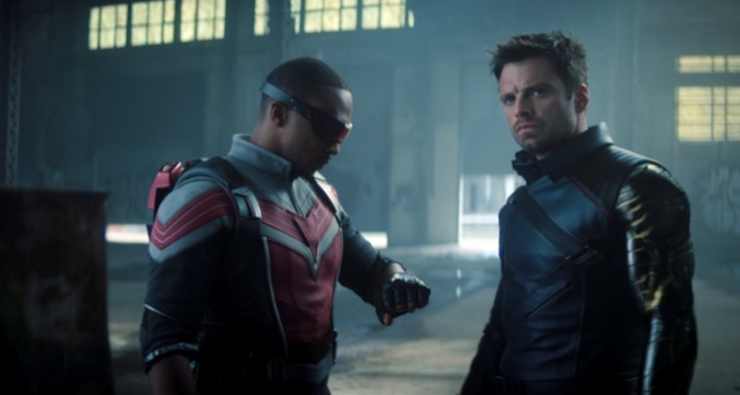It looks like The Falcon and the Winter Soldier is determined to work in as many of the people who’ve been Captain America as possible—not to mention several who’ve been some form of “Bucky” and the Falcon. I neglected to mention last week (either in my review of episode one or in my brief history of the title characters in the comics) that Falcon’s intelligence officer in this TV series, Joaquin Torres, is the name of the character who took over as Falcon when Sam Wilson became Captain America in the comics.
And we get two more Caps and one more sidekick this week.
We open on John Walker doing an interview at what is supposed to be his high school football field, but that’s totally a college football stadium. Whatever, Walker gets a big marching band and dancing and stuff to an updated version of “The Star-Spangled Man,” the propaganda song that was the main number in Steve Rogers’ USO tour when he first donned the costume in Captain America: The First Avenger.
Walker is a special-ops officer who has won three medals of honor and who has trained with the shield that Sam Wilson donated to the Smithsonian last episode. Not sure when he had time for that, but we’ll let that pass. Both Wilson and Bucky Barnes watch this interview with disgust.
His sidekick, a fellow member of his special-ops team, is Lemar Hoskins, who has the codename Battlestar. Wilson has traced the Flag Smashers to Munich, and what starts as a solo mission turns into a team-up: Bucky Barnes pretty much forces himself onto Wilson’s mission, and during a fight with the Flag Smashers atop two moving trucks, the new Cap and Battlestar show up to help out.
Not that any of them are much help. The Flag Smashers all appear to be enhanced by some kind of version of the Super Soldier Serum, and they kick all four heroes’ asses pretty good, also destroying Redwing.
This leads us to my favorite scene in the episode, when Barnes takes Wilson to Baltimore.
It starts with some delightful meta-commentary on the tendency throughout the 1960s and 1970s of so many superheroes of color to be given names that start with the word “Black”—Black Panther, Black Goliath, Black Lightning, etc.—by having a little kid refer to Wilson as “Black Falcon.” Then they visit Isaiah Bradley—the black Captain America.
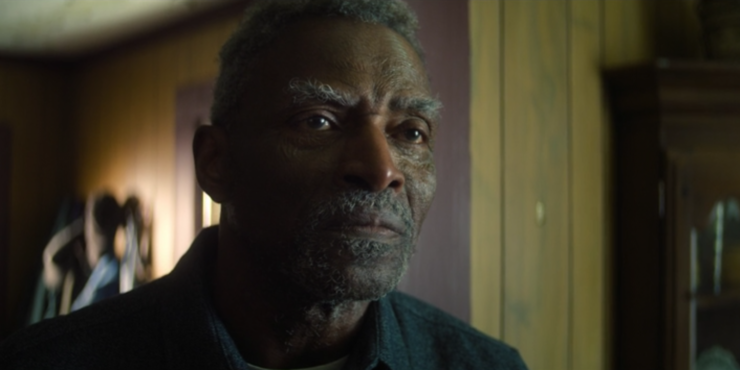
Bradley worked as a superhero for the government past the days of World War II, and the Winter Soldier clashed with him in 1951. Bradley did some damage to his artificial arm, too. But Bradley doesn’t want anything to do with anybody and kicks them both out of the house, after showing that he still has his super strength at his advanced age. Wilson is aghast that he himself never heard of Bradley, and even more aghast to discover that Barnes never told Steve Rogers about Bradley.
Carl Lumbly has never not been superb in anything he’s been in, and he knocks it out of the park as the elderly, angry Bradley. He talks of being in jail and being experimented on. The U.S. government doesn’t come across all that great here, having already christened a new Captain America and with the implications of what happened to Bradley. On top of that, the Flag Smashers are seen here to be bringing medicine to people in refugee camps—these are the bad guys that the government is sending both Captain America and the Falcon to stop.
The questioning of authority hovers over everything here, including the end of the scene with Bradley. Wilson and Barnes are arguing in the street—specifically in the streets of a not-particularly-affluent section of Baltimore—which leads to two cops showing up and assuming that a black man arguing with a white man means trouble. They calm down when they recognize Wilson as famous, as famous black people obviously aren’t dangerous. But then they have to arrest Barnes, because it turns out that when he tagged along with Wilson to Munich, he also missed his therapy session, which violates the terms of his pardon.
The therapy session this leads to is my second favorite scene, as Dr. Raynor tries to get both heroes to open up. Barnes does, at least—his issue with Wilson is that he gave up the shield. Rogers bequeathed it to him, and he rejected it, which leads Barnes to think that Rogers may have been wrong about Wilson, which means he may have been wrong about Barnes, too. Since Rogers’ faith in Barnes is the only reason he’s any kind of good person now, this possibility worries Barnes greatly.
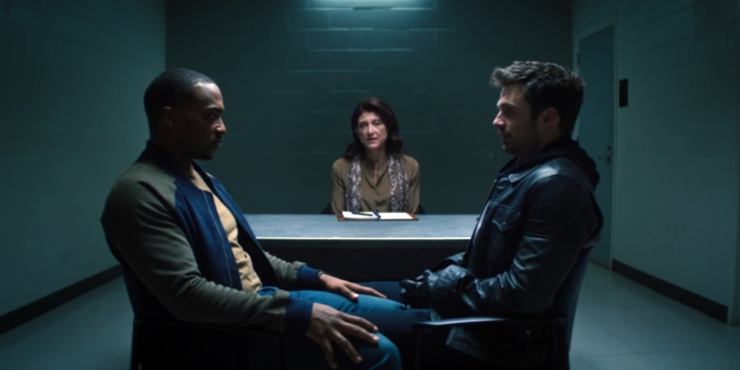
Wilson, however, still thinks he did the right thing, regardless of whether or not Barnes or Rogers could possibly understand it. And if nothing else, seeing how Bradley wound up, in contrast to how Rogers wound up, is a pretty telling point in Wilson’s favor…
The performances here are stellar. One of my disappointments in the first episode was that we didn’t get Barnes and Wilson together, but episode two makes up for that in spades. Anthony Mackie and Sebastian Stan spend pretty much the entire episode together, and it’s magnificent. These two have magnificent chemistry, which we saw hints of in Captain America: Civil War, and which is on full display here.
Wyatt Russell also does great work, playing the humble aw-shucks-I’m-just-doin’-my-job soldier who’s trying to do the right thing. He’s doing this because he was ordered to, and he considers it a great honor. Russell strikes a very good balance here, as he’s not really a bad guy, but it’s also hard to warm to him, at least in part because his persona as Captain America is so obviously manufactured. He’s trying to fill Rogers’ shoes, but he hasn’t really done anything to earn the accolades he’s been getting. The people in the football stadium are cheering the uniform and the shield, not the person wearing it. Heck, Rogers himself didn’t get taken seriously as a soldier until he rescued a bunch of prisoners from Hydra’s clutches.
Walker also very obviously has some serious combat skills, but those skills may not mean much. For all that Walker and Hoskins try to take credit for saving Wilson and Barnes’ lives when they unsuccessfully try to stop the Flag Smashers, the fact is, they also got their asses kicked and did, basically, no damage to the Flag Smashers at all.
Plus, again, the Flag Smashers don’t seem to be all that bad. They’re labelled as terrorists, and they certainly were disruptive last week, but their goals aren’t entirely horrible, either. At the very least, there are shades of gray here.
I expressed hope that things would move forward this week, and I got what I wanted. Our title heroes are now working together, and we’re seeing progress. On top of that, the Big-Ass Action Sequence was much better, and actually plot relevant. (I think everyone was a little too good at keeping their balance on top of a moving truck, but it was still a fun, exciting action scene.) There’s not a bad performance in the bunch, either, and even if the rest of the show was awful (and it isn’t), I’d be here for the Mackie-Stan banter, which just sparkles.
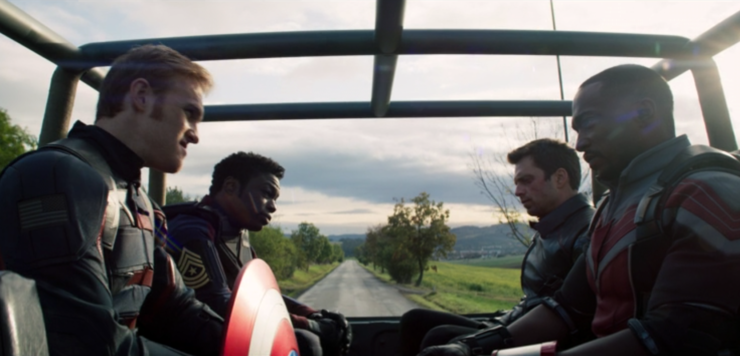
Odds and ends
- In the first paragraph I referred to “Bucky” in quotes. When Walker took over as Captain America in the comics, in a run that was written by the late Mark Gruenwald, he also had an African-American sidekick named Lemar Hoskins, who took on the name Bucky. The late Dwayne McDuffie—who was one of the most prominent comics writers of color, and who later co-founded Milestone Media—gently informed the white Gruenwald that “buck” was a racial slur, and maybe don’t call him that? His name was changed to Battlestar. FWS thankfully skips the first step, with Hoskins using the Battlestar name from jump.
- Isaiah Bradley is based on a comics character introduced in the brilliant 2003 miniseries Truth: Red, White, and Black by Robert Morales & Kyle Baker. That comic established that Rogers wasn’t the only one who got the Super Soldier Serum. Several African-American soldiers were experimented on with the formula also, though only one of them survived to the end of the war, and most didn’t survive the experiments at all. The few who made it through the treatments went on secret missions for the Allies. At one point, Bradley stole a Captain America uniform and went on a solo mission behind the lines, and wound up being captured by Hitler. The comic is fantastic, a stark look at how the U.S. government that gave us stuff like the Tuskegee Experiments would really test the Super Soldier Serum before they gave it to the blond-haired, blue-eyed white guy. In particular, Morales and Baker did a good job of reminding readers that the U.S. was all about eugenics and preserving the white race in the first half of the 20th century. I really hope the MCU version of Bradley follows the comics’ example and doesn’t pull any punches.
- I like that John Walker is less of a dick than he is in the comics. Originally created as the Super Patriot at the height of the Reagan era, he was very much a product of the same period in pop culture that gave us Rambo and his ilk, and I like this version better. Mind you, he’s still a bit of a dick, but the comics version of Walker carried himself like he thought he deserved the shield, while the MCU Walker is more self-effacing about it.
- In the comics, it was established that two other people took on the mantle of Captain America during World War II after Cap and Bucky’s apparent death. One was Jeff Mace, a.k.a. the Patriot, a version of whom we saw in the Agents of S.H.I.E.L.D. TV series played by Jason O’Mara. The other was William Nasland, a.k.a. the Spirit of ’76, who has yet to have an MCU counterpart. I also neglected to mention one other substitute Cap in the modern era: the ill-fated Roscoe Simons, who took on the role after Cap quit in Captain America Vol. 1 #176 by Steve Englehart & Sal Buscema (1974). Simons was killed rather brutally by the Red Skull, which inspired Rogers to take up the shield once again.
- As much as I adore the conversation between Wilson and Barnes about “the Big Three,” it’s not quite accurate. Wilson insists that every bad guy they face is either an alien, an android, or a wizard. But while that’s true of some (Loki, Thanos, Ultron, Malekith, Ronan, Kaecilius, Hela, Ego, Yon-Rogg), a goodly number of the MCU bad guys are regular humans who’ve been enhanced either chemically or with technology (Stane, Whiplash, the Abomination, the Red Skull, Killian, Yellowjacket, Vulture, Killmonger, the Ghost, Mysterio, and, of course, the Winter Soldier). Heck, some aren’t even enhanced: the hordes of Hydra, for example, not to mention Zemo. And the Flag Smashers seem to fall into the enhanced-human category as well…
- Having said that, I love that Barnes read The Hobbit when it first came out in 1937. That is a perfect touch.
- Speaking of Zemo, he finally shows up—in the final scene brooding in his jail cell after Wilson and Barnes decide they’re going to go talk to him. Which makes sense, as the Super Soldier Serum got its start with Hydra (remember in The First Avenger, we learned that the Red Skull was the first recipient of the formula before Dr. Erskine defected to the U.S.).
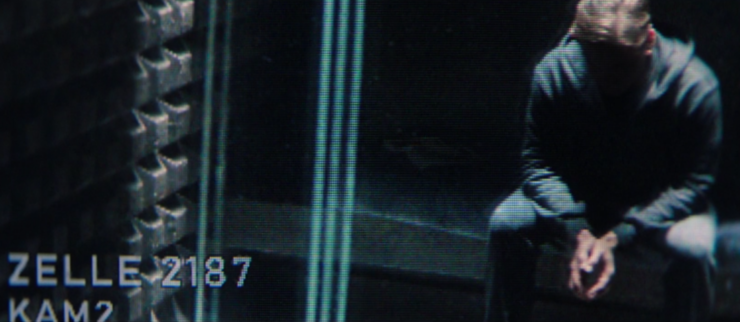
Keith R.A. DeCandido also does the Star Trek: Voyager Rewatch every Monday and Thursday. His takes on the MCU films can be found in his “4-Color to 35-Millimeter: The Great Superhero Movie Rewatch” that started on this site in 2017.










